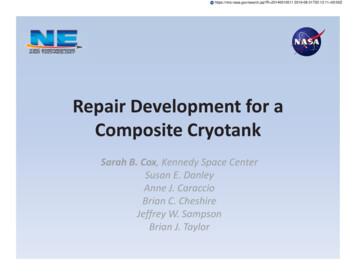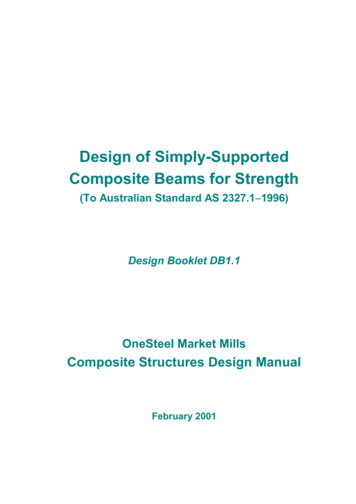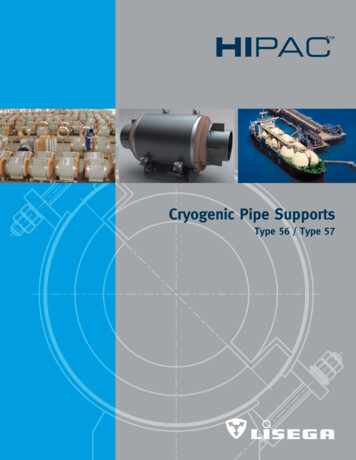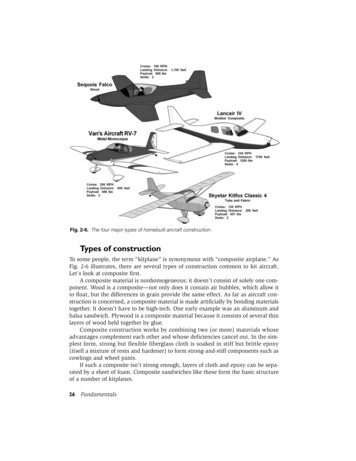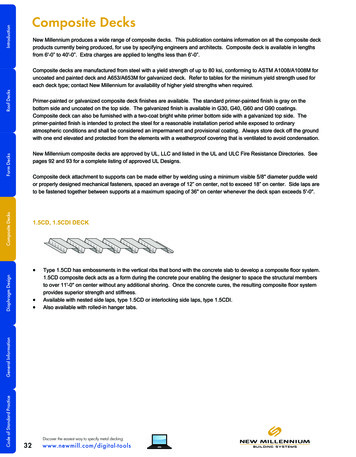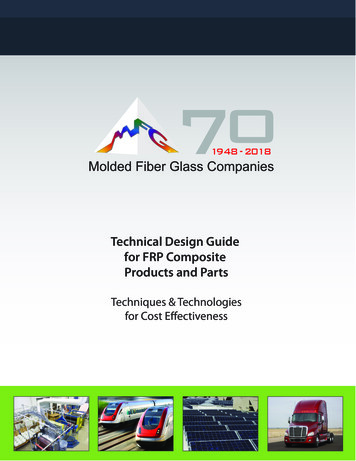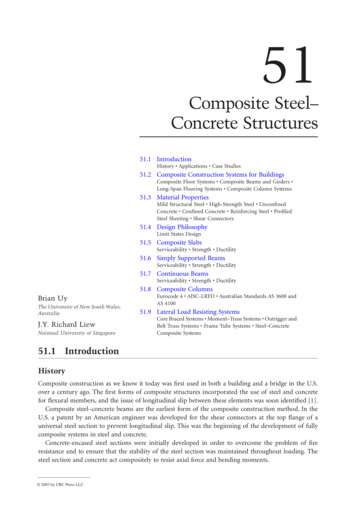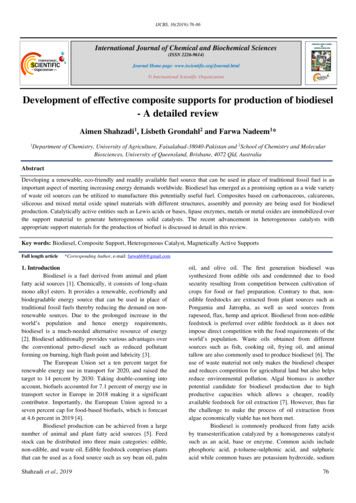
Transcription
IJCBS, 16(2019):76-86International Journal of Chemical and Biochemical Sciences(ISSN 2226-9614)Journal Home page: www.iscientific.org/Journal.html International Scientific OrganizationDevelopment of effective composite supports for production of biodiesel- A detailed reviewAimen Shahzadi1, Lisbeth Grondahl2 and Farwa Nadeem1*1Department of Chemistry, University of Agriculture, Faisalabad-38040-Pakistan and 2School of Chemistry and MolecularBiosciences, University of Queensland, Brisbane, 4072 Qld, AustraliaAbstractDeveloping a renewable, eco-friendly and readily available fuel source that can be used in place of traditional fossil fuel is animportant aspect of meeting increasing energy demands worldwide. Biodiesel has emerged as a promising option as a wide varietyof waste oil sources can be utilized to manufacture this potentially useful fuel. Composites based on carbonaceous, calcareous,siliceous and mixed metal oxide spinel materials with different structures, assembly and porosity are being used for biodieselproduction. Catalytically active entities such as Lewis acids or bases, lipase enzymes, metals or metal oxides are immobilized overthe support material to generate heterogeneous solid catalysts. The recent advancement in heterogeneous catalysts withappropriate support materials for the production of biofuel is discussed in detail in this review.Key words: Biodiesel, Composite Support, Heterogeneous Catalyst, Magnetically Active SupportsFull length article*Corresponding Author, e-mail: farwa668@gmail.com1. IntroductionBiodiesel is a fuel derived from animal and plantfatty acid sources [1]. Chemically, it consists of long-chainmono alkyl esters. It provides a renewable, ecofriendly andbiodegradable energy source that can be used in place oftraditional fossil fuels thereby reducing the demand on nonrenewable sources. Due to the prolonged increase in theworld’s population and hence energy requirements,biodiesel is a much-needed alternative resource of energy[2]. Biodiesel additionally provides various advantages overthe conventional petro-diesel such as reduced pollutantforming on burning, high flash point and lubricity [3].The European Union set a ten percent target forrenewable energy use in transport for 2020, and raised thetarget to 14 percent by 2030. Taking double-counting intoaccount, biofuels accounted for 7.1 percent of energy use intransport sector in Europe in 2018 making it a significantcontributor. Importantly, the European Union agreed to aseven percent cap for food-based biofuels, which is forecastat 4.6 percent in 2019 [4].Biodiesel production can be achieved from a largenumber of animal and plant fatty acid sources [5]. Feedstock can be distributed into three main categories: edible,non-edible, and waste oil. Edible feedstock comprises plantsthat can be used as a food source such as soy bean oil, palmShahzadi et al., 2019oil, and olive oil. The first generation biodiesel wassynthesized from edible oils and condemned due to foodsecurity resulting from competition between cultivation ofcrops for food or fuel preparation. Contrary to that, nonedible feedstocks are extracted from plant sources such asPongamia and Jatropha, as well as seed sources fromrapeseed, flax, hemp and apricot. Biodiesel from non-ediblefeedstock is preferred over edible feedstock as it does notimpose direct competition with the food requirements of theworld’s population. Waste oils obtained from differentsources such as fish, cooking oil, frying oil, and animaltallow are also commonly used to produce biodiesel [6]. Theuse of waste material not only makes the biodiesel cheaperand reduces competition for agricultural land but also helpsreduce environmental pollution. Algal biomass is anotherpotential candidate for biodiesel production due to highproductive capacities which allows a cheaper, readilyavailable feedstock for oil extraction [7]. However, thus farthe challenge to make the process of oil extraction fromalgae economically viable has not been met.Biodiesel is commonly produced from fatty acidsby transesterification catalyzed by a homogeneous catalystsuch as an acid, base or enzyme. Common acids includephosphoric acid, p-toluene-sulphonic acid, and sulphuricacid while common bases are potassium hydroxide, sodium76
IJCBS, 16(2019):76-86hydroxide, and sodium silicate The process convertstriglycerides from the oil into alkyl esters in the presence ofthe catalyst and an alcohol (methanol or ethanol) and forms"glycerol" as a by-product [8]. Modern approaches includesupercritical and superheated transesterification. Thesupercritical method involves the application of hightemperature and pressure to assist conversion of the oil intobiodiesel. This result in rapid formation of a high-qualityproduct requiring low amounts of catalyst, however, at theexpense of high energy consumption required to achievehigh temperature and pressure making the entire process lesseffective.The use of acids or bases as catalysts in thetransesterification poses problems of corrosion of the reactorand engine. Moreover, a considerable amount of energy isrequired to remove the catalyst from the reaction mixtureand saponification of free fatty acids is also a problem [9].Therefore, to overcome these problems, functionalizedheterogeneous catalysts are used for the transesterificationreaction. Such heterogeneous catalyst are stable, effective,reusable and environment friendly and they improve theproduct purity, while producing less waste water and thusresulting in low environmental pollution. Heterogeneouscatalysts include metal oxides, doped metals, mixed oxides,supported alkali metals, zeolites and minerals [10].Enzymatic conversion of oils to biodiesel is an effective waythat involves the use of lipase enzymes either as a freecatalyst or functionalized over a support surface [11]. Inspite of its effectiveness for catalyzing various feedstockswith larger free fatty acid ratios, the large manufacturingprice of enzymes renders it difficult to use on an industrialscale.A support material is a substance that is used tofunctionalize a catalytically active entity at its surface toperform the function of catalysis. It provides the largerconcentration of reactant-catalyst contact sites compared totraditional heterogeneous catalysts, while maintaining theadvantage of easy removal from the reaction mixture. Thecorrosive effects of pure acids or bases can be mitigated bythe use of a support material [12]. A number of differentsupport materials produced from different sources have beeninvestigated. Waste biomass derived supports such asbiochar, carbonaceous, calcium-based and mineral-basedsupports have been used effectively. Porous materials suchas silica, alumina or carbon-based nanoparticles anddifferent composites is another class of suitable supports[13]. Magnetically active specifically designed supportmaterials are also being tested as their magnetic propertyallows the efficient removal and recycling of the catalyst.Amongst the waste derived supports, biochar is derivedfrom plant wastes such husks and calcium-based supportsare derived from sea animal shells, eggshell, waste marinebarnacles or calcareous rocks [14]. Furthermore, differentminerals which are porous in nature have been used asShahzadi et al., 2019support material. These include dolomite, kaolinite, calciteand bauxite.A support material that is made of two or morecharacteristically different components is referred to as acomposite support material. A number of compositesupports have been extensively investigated to evaluate theirefficiency and feasibility. Carbonaceous composite supportsinclude single walled carbon nanotubes (SWCNT), carbonnanohorns (CNHs) and multiwalled carbon nanotubes(MWNT), activated carbon and doped carbon-basedcomposites [15]. Composite siliceous supports can beproduced from meso, micro and nano-porous silicacombined with metals, metal oxides and other inorganicmaterials. A very small number of calcareous compositeshave been reported to be used as support because mainlythis class when used in pure form as CaO produced fromcalcination display considerably good catalytic properties[16]. A few studies evaluated the use of composite materialmembranes that have functionalized surfaces and are beingused as heterogeneous catalysts. Simple metal compositesare also being used as support for the catalyst for efficientproduction of biodiesel [17].The research into fabrication of effective compositesupports for biodiesel production is a relatively new fieldthat has increased significantly over the past five yearsbased on a search in the database Web-of-Science. In 2018 areview paper was published in the journal Catalyst whichfocused on biochar-based catalysts including compositesupports [18]. This present review will give detaileddescription of a range of different types of compositesupports and will also provide an overview of theeffectiveness of these supports for biodiesel production.2. Methods for Development of Composite SupportsComposite support materials can be synthesized byvarious methods. Table 1 gives an overview of the mostcommon methods for their synthesis. The method offormation affects the size, structure, assembly andarrangement of molecules in the composite. Mostcomposites are meso-porous or nano-porous and can beproduced using co-precipitation, sol-gel and impregnationmethods. The co-precipitation method is the most commonand conventional method for the synthesis of nano-porousmaterials, in which reactants are co-precipitated in an inertsolvent at relatively high temperature. Micro-emulsion isanother promising method for nanocomposite supportformation in which an aqueous system of surfactant and cosurfactant agents, are dispersed with fine oil droplets of 50to 500 nm size range. Core shell structured composites havean inner core of a metal oxide over which an organic orinorganic layer is synthesized. Most core shelled compositesare magnetically active such as ferromagnetic, for example,superparamagnetic iron oxide cores are common.77
IJCBS, 16(2019):76-86Table 1. Common methods for the preparation of malSiO2-Fe3O4,[19-20]CoHydroxyapatite -γ-Fe2O3[21]precipitationand MgO-ZrO2MiniPEGylated lCa/Al/Fe3O4[19]SynthesisSol-gelGPTMS aO-Fe3O4 and[24-25]diatomite/CaO-MgOThere is a variety of composite supports as outlined inSection 1. The relative number of reported studies fordifferent types is shown in Fig. 1. The following sections ofthis review will describe these different types in detail.Fig.1 Ratio of composite supports reported in last 10 years3. Carbon-Based Composite SupportsCarbon has proven to be an excellent contender asa heterogeneous catalyst or catalyst support. The chemicalproperties of electron conductivity and inertness makes it areliable candidate in chemical and especially catalyticprocesses. Carbon derived from cheap environmentalsources (e.g. tea waste), when used as a catalyst or catalyticsupport, makes the product cost effective. Moreover, it playsan important role in combating the increasing environmentalpollution. When functionalized with catalytically activeentities such as acidic or basic group containing moieties,metals, enzymes etc., carbon gives efficient, stable andremarkably reusable catalysts, which not only lower theprice of biodiesel synthesis on an industrial scale but alsoimproves the quality of the product. This is a major reasonthat much research is ongoing to invent better carbon-basedheterogeneous catalysts or catalytic supports. A briefsynopsis of the carbonaceous composite supports that havebeen used is given below. An overview of some key studies,are given in Table 2A.3.1 Nano Structured Carbon Composite SupportsNano-structured carbon materials such SWCNT,CNHs, MWNT and graphene have been frequently used assupport materials to synthesize heterogenous catalysts.Shahzadi et al., 2019Carbon provides the benefit due to its inert nature and whenin nanoparticle form, it gives large surface area, moreefficient active sites for catalysis as well as better stability[26]. Nano-carbon supports can be functionalized withsimple effective acidic or basic entities or these arecombined with magnetically active metals. Magneticremoval of the catalyst simplifies the catalyst removalprocess and wastewater generation. A comparison betweenCaO dispersed CNHs and calcium ferrite supported overCNH was reported. Due to hybridization of basic sites ofcalcium ferrite with hydrophobic CNHs, the catalyst showedenhanced activity compared to the CaO-based catalyst. Thehydrophilic glycerol produced is discarded due to thehydrophobic nature of the support. As a result, the activesites are available for the reactants to approach resulting in97.1% yield of biodiesel [27].Single walled carbon nano-horn (SWCNH) weresulfonated and mixed with iron nanoparticles Fe2O3 toproduce a composite support for iron-based heterogeneouscatalysis for the production of biodiesel from tributyrinwhich yielded a methyl-butyrate product. This studyrevealed that the use of magnetically active support attractedthe reactants towards it so that the free fatty acids did notcause poisoning of the catalytic sites and did not affect thebiodiesel yield [27].3.2 Graphene Oxide (GO)-Based CompositesBecause of its high surface area (up to 2600m2/g),excellent adsorbing quality due to p-p interactions and highcarrier mobility, graphene is good catalyst support. Metaloxide supported sulphonated carbon-based materials haveproven to be more efficient, stable and readily availablesolid acid catalyst as opposed to conventional acidsupported catalysts because of the presence of both Lewisand Brønsted acid sites. Due to low surface area and acidicleaching, some early carbonaceous acid catalysts wererejected. This lead to the development of novel sulphonatedsolid composite support such as graphene oxide with Fe2O3(GO Fe2O3@SO3H) which is magnetically active. Thiscatalyst was used in the transesterification of oleic acid fromwaste cooking oil along with ethanol. The GO Fe2O3@SO3Hcatalyst showed high catalytic activity as well asrecyclability due to its magnetic properties. This supportwas found to be better than GO, GO-SO3H and GO-Fe2O3.The maximum yield of biodiesel was obtained in 4 hours, at100 C using 5 % by wt. of the catalyst. A single stepconversion of waste cooking oil (WCO) to biodiesel couldbe achieved at 90oC in 6 h using 5wt % of the catalyst. Thecatalyst was recovered by applying external magnetic fieldand was able to be reused for 7 cycles [28].3.2.1 Enzyme Modified Graphene Oxide CompositesAnother solid GO-based catalyst involvedfunctionalized GO with lipase enzyme immobilized on itssurface to perform the catalytic activity. This nanobiocatalyst has a magnetically active iron oxide core that78
IJCBS, 16(2019):76-86makes it recyclable and it can be used in up to 5 consecutivecycles after applying a simple washing procedure at the endof use. The enzymes were immobilized by covalentcrosslinks over the composite support in the form ofaggregates (CLEAs-lip). GO provides a good coatingmaterial both for magnetic nano-particles and tofunctionalize the lipase enzyme due to reactive functionalgroups and high surface activity. A good biodiesel yield of78% was achieved in 24 hours [29].Another magnetically recyclable GO support isreported in which lipase from Candida Rugosa ulated GO. The biodiesel was synthesized at 40 C bythree step addition of methanol in a shaking water bath.Approximately, 92.8% conversion of soybean oil wasobtained through transesterification. A recyclability of 5times without considerable loss of activity was achieved byapplying an external field [30].3.3 Metal Doped Carbon Composite SupportsMetal doped carbonaceous catalysts have beenused efficiently for biodiesel production e.g., iron dopedactivated carbon showed 96.3% conversion of rubber seedoil to biodiesel with minimal loss (0.8–1.2%) in catalyticactivity after three cycles. The electron availability of thetransition metal and high surface area of the activatedcarbon are the reasons for high catalytic activity shown bysuch types of catalysts. The catalyst without metal ionspresent showed a decreased % age yield even at hightemperature of 100oC in 6 hours reaction time [31]. Amixture of oxides of different metals including Ca, Mg, Fe,Al and K derived from waste slag was used as aheterogeneous basic catalyst. The results showed that muchresistance resulted in lowering of active site accessibilityand caused a low rate of reaction [32].3.4 Metal Organic FrameworksAnother proposed structure to be used as a supportis a metal organic framework over which any catalyzingentity could in theory be immobilized. A few such nanoporous carbonaceous supports have been investigated.Zhang et al. has reported a lipase immobilized support,which has a carbonized aluminum support. It proved to bean excellent catalyst as it gave 100% biodiesel yield with arecyclability of several times. The catalytic activity,however, was diminished to yield only 20% of biodiesel bythe 9th cycle. The pore morphology played a role in the highbiodiesel yield as a result of the high surface area.4. Calcareous Composite SupportsCalcium-based composites may be synthetic ornaturally derived. Waste materials including eggshells, andmarine-based structures such as shells and barnacles are richsources of calcium carbonate (CaCO3) which uponcalcination is converted into CaO. This provides a costeffective, readily available support material. CaO can alsoShahzadi et al., 2019be obtained from mineral sources such as dolomite. Table2B detail a selection of studies.CaO is not only a good basic catalyst fortransesterification reactions but can also be used as a supportmaterial when combined with other metal oxides. ACaO/MgO composite was used as support material withdiatom skeletons attached for the biodiesel production fromwaste cooking oil. This assembly provided a considerableopportunity for the synthesis of biodiesel at an industriallevel using a novel, cost effective and easily availableheterogenous catalyst. The Diatomite@CaO/MgO catalystgave 96% oil conversion in 120 min at 90 C using 6 wt%catalyst and 1:15 oil:methanol ratio. The catalyst was alsorecyclable several times [25].Hydroxyapatite-encapsulated γ-Fe2O3 nanoparticlesserved as another novel calcium-containing compositesupport over which bigunide was covalently attached toperform the function of a catalyst. The heterogenous catalystwas magnetically active and recyclable. It was used in thetransesterification of soybean oil with methanol. A bettercatalytic activity was reported with 99.6% biodiesel yield in3 hours reaction time and a methanol:oil molar ratio of 25:1and a catalyst loading of 3 wt%. Simple magnetic separationof the catalyst as well as efficient recyclability of 5consecutive cycles was also reported. Another calciumoxide and iron oxide composite (CaO/Fe3O4) was used assupport for a potassium fluoride (KF) catalyst. Theferromagnetic catalyst could easily be recovered byapplication of an external magnetic field. Its characterizationwas done by vibrating sample magnetometer (VSM) toevaluate the magnetic susceptibility of this compositesupport. The porous catalyst produced a good biodiesel yieldof 95% at optimal conditions [24].Carbonated alumina doped by calcium oxide hasalso been studied for the transesterification reaction. Thecatalyst was synthesized by a microwave combustionmethod and used to convert canola oil to biodiesel. Almost98.8% yield was obtained without loss in catalytic activity[33].5. Silica-Based Composite SupportsSilica has been shown to be a versatile supportmaterial which can be produced in different particle sizes.These can be used with other materials to form a novel,efficient and cost effective composites support. Muchresearch has reported silica-based composites used assupport materials. Table 2C outlines some key studies forthis group of composite supports. Magnetically active Fe3O4composites with silica was functionalized with Ca toproduce a nanocatalyst for biodiesel production;Ca/Fe3O4@SiO2. The highest oil conversion was obtained at15 to 1 methanol to oil ratio, at a temperature of 65 C afterconstant mechanical stirring for 5 hours. Thecharacterization revealed that a more basic catalystimproved the biodiesel production and that the catalyst was79
IJCBS, 16(2019):76-86magnetically active and could be recycled for several timeswithout appreciable loss in activity [34].Another study reported calcium sulphatefunctionalized core shell nano-structures incorporated intomesoporous silica nanoparticles; CaSO4/Fe2O3-SiO2. Thecontrollable nature of size, shape and surface propertiesallowed gauging the physical and chemical properties of thenanocatalyst. The catalysts showed a good yield of biodieselof more than 94%. The magnetic properties of the core shellparticles made the catalyst easily recoverable by simplyapplying an external magnetic field, which improved itsreusability for several cycles (up to 9) without showing adiminished catalytic activity. The morphology, porosity andconjugated structure of the CaSO4/Fe2O3-SiO2 catalyst wereevaluated systematically [20].A series of magnetic CsH2PW12O40/Fe–SiO2 nanocatalysts were prepared via a combination of the sol–gel andimpregnation methods. The effects of differentH3PW12O40/(Fe–SiO2) weight percentage, loading of Cesium(Cs) as a promoter and calcination conditions on thecatalytic performance was studied. It was found that thecatalyst with H3PW12O40/Fe–SiO2 4 wt.% and Cs 2 wt.%was an optimal catalyst for biodiesel production. Theactivity of this catalyst was studied in different operationalconditions and the best conditions were CH3OH/oil 12/1 at60 C with mechanical stirring rate of 500 rpm. This resultedin a biodiesel yield of 81% in 4 hours [35].A mesoporous silica-based iron oxide core-shellstructure, Fe3O4/MCM-41, was prepared and functionalizedwith sodium silicate such that no structural damage to themagnetic support occurred. Epichlorohydrin was used ascross-linking agent to attach a basic catalyst on the magneticcomposite support. This catalyst was shown to be efficient,stable and easily recyclable 5 times with oil conversionreaching up to 99.2% by using the methanol:oil molar ratioof 25:1 and a catalyst loading of 3 wt% at reflux of methanolover 8 hours of reaction [36].A number of silica composites have been shown tobe excellent substrates for immobilization of lipase with theuse of a cross-linking [37]. Studies have compared the useof the immobilized enzyme to a free enzyme in solutionused as the catalyst and results has shown a far betterbiodiesel production when using immobilized enzyme. Amagnetically active mesoporous silica and iron oxidecomposite was reported to give 91% biodiesel yield atmediated reaction conditions. The analysis was made usingresponse surface methodology (RSM) to predict themaximum FAME (fatty acid methyl esters) contents at theoptimum condition. Moreover, the immobilized lipase couldbe used four times without considerable loss of the activity.Minerals are a good source for production ofcomposites. They can be coated with nano-porous andmesoporous silica to synthesize composite supports forheterogeneous catalysts. Enzyme immobilized silica coatedShahzadi et al., 2019magnetite was used as a novel biocatalyst for biodieselproduction. A number of cross-linking agents can be used toattach the enzyme to the surface off the support, for examplegluteraldehyde and aminosilane [38]. Synthesis of anenzyme immobilized (Fe3O4@SiO2) catalyst in which ionalized to provide a matrix for the enzyme. Close to100% conversion was obtained at optimum reactionconditions [23]. A superparamagnetic iron oxide core-shellsilica support functionalized with aldehyde groups wasmanufactured by Karimi et al. A 91% biodiesel yield wasobtained when using waste cooking oil as feedstock atreaction conditions of methanol:oil molar ratio of 6:1,immobilized lipase concentration of 25 wt%, n-hexanecontent of 10 wt%, water content of 10 wt%, reactiontemperature of 35 C, and reaction time of 35 hours [39].Two more research studies reported aminosilanefunctionalized superparamagnetic iron oxide cored silicananoparticles which were then immobilized with lipaseenzyme. Both nanocomposites were prepared by coprecipitation method [39].Both organic and inorganic catalytic entities can beattached to a support surface. Heteropolyacids was attach tomagnetic nanoparticles to catalyse the transesterificationpalmitic acid which gave 90.4% oil conversion in 2 hours. Thehybrid support had a central core of iron oxide over which asilica shell was formed to attach an amino-silane and to this, theheteropolyacids on the surface. The magnetic susceptibilityallowed easy catalyst separation as well as recycling for 5 cycles[40]. Another Core–shell Fe3O4@silica magnetic nanoparticle composite functionalized with triazabicyclodecene(TBD), was evaluated for is catalytic effect for theproduction of biodiesel from algal feedstock. An appreciableyield of 97.1% was obtained at optimum reaction conditions[40]. The silane agents 3-aminopropyltriethoxysilane(APTES) and 3-mercaptopropyltrimethoxysilane (MPTMS)were used as immobilization matrix. A Fe3O4 core with asilica shell was treated with dimethyl octadecyl [3(trimethoxysilyl) propyl] ammonium chloride as animmobilization supporter. The Burkholderia lipase wasimmobilized to the synthesized nanoparticles to be used forproduction of biodiesel [41].A novel magnetically separable nanocatalyst wasfabricated by covalent bonding of 3-sulfopropyl-1-(3propyltrimethoxysilane) imidazolium hydrogen sulfate([SO3H-PIM-TMSP]HSO4) on mesoporous silica modifiedFe3O4 nanoparticle. Approximately, 93.5% of oleic acidfrom different feed stock was converted into the finalproduct even at mild reaction conditions such as 373 Kreaction temperature and a reaction time of 4 hours. Themagnetically active catalyst showed a high specific surfacearea, mesoporous channel and good catalytic activity [42].6. Composite Membranes Used as Supports80
IJCBS, 16(2019):76-86A recent trend investigates the use of a compositecatalytic membrane that acts as a support material for theattachment of a catalyst on its surface. A phosphotungsticacid (PWA)/poly(vinyl alcohol) (PVA) membrane wasmanufactured via electrospining on a substrate of nonwoven fabric. The nano-fibrous PWA/PVA membrane hadfiber diameters of 157 nm as characterized by SEM. Furtherevaluation using DSC and TGA showed good thermalstability for 10 days in the rage of 30 C to 600 C at aheating rate of 10 C/min and indicated interaction betweenPWA and PVA. The stability test of the nano-fibermembrane suggested that the conversion could remain stablefor 10 days in a continuous flow-through reactor forbiodiesel production [43].A number of different GO/chitosan compositemembranes have been evaluated for their ability to performthe function of support for catalyst in biodiesel production.A study reported esterification of acetic acid and preesterification of palmitic acid in the presence of alcohol. Thereaction and separation could be carried out eithersimultaneously or separately. The outcome determiningparameters were found to be methanol to oil ratio,temperature and the amount of embedded graphene oxide asthese directly affect the kinetics of the reaction [44].Membrane-immobilized enzymes have receivedincreasing attention in a variety of fields such as biosensors,enzymatic reactors and membrane bioreactors. In one study,Candida rugosa lipase (CRL) was covalently immobilizedon a nanocomposite membrane. Initially, the Fe3O4@SiO2nano-particles were dip-coated onto the ultrafiltrationmembrane surface through a low temperature hydrothermal(LTH) process, and then reacted with APTES.Glutaraldehyde was used as a coupling agent to covalentlyimmobilize lipase on the nanocomposite membrane surface.The results showed that the immobilization process wassuccessful in terms of enzyme activity and immobilizationefficiency. It was found that the activated nanocompositemembrane greatly improved the relative activity and loadingcapacity in comparison to the unmodified membrane. Aninvestigation of the kinetic parameters of the enzymaticreaction showed a decrease of Km and vmax values due to theimmobilization process, which represents an increasing insubstrate affinity and decrease in catalytic activity of theimmobilized enzyme. The higher thermal stability, longterm storage and operational stability of immobilizedenzyme make it a suitable candidate for bio-catalyticprocesses.7. Mixed Metal Oxide Composites Used as SupportsMixed metal oxides in composites have been usedas support materials. Key examples of such composites areshown in Table 2D. One example is a study by Zhang et al.evaluating CaO/ZnFe2O4, CaO/MnFe2O4 and CaO/CoFe2O4.Although all of them proved to be good catalysts to carryout the transesterification reaction with soybean oil andShahzadi et al., 2019alcohol, a comparison was made to evaluate the catalyticperformance. It was found that CaO/CoFe2O4 had the bestcatalytic performance and this was attributed to its highwettability that resulted in good contact between the catalystand the reactants [45].In another paper by Zhang et al., (MgFe2O4@CaO)was fabricated by an alkali precipitation method and wasutilized for biodiesel production from soybean oil andmethanol. The catalytic efficiency was compared to a pureCaO catalyst. A good percentage yield of 98% was obtainedwith catalyst recyclability of 5 cycles. Optimal reactionconditions were a catalyst dosage 1.0 wt.%,methanol:soybean oil ratio of 12:1, reaction temperature of70 C, and a reaction time of
potential candidate for biodiesel production due to high productive capacities which allows a cheaper, readily available feedstock for oil extraction [7]. However, thus far the challenge to make the process of oil extraction from algae economically viable has not been met. Biodiesel is commonly produced from fatty acids
